Combining work and play
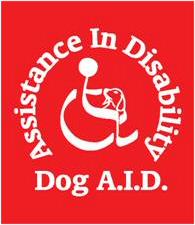 Elaine Fairhurst is a volunteer for Dog A.I.D.
(Assistance In Disability) a national voluntary organisation which provides specialised
training for people with physical disabilities and their own pet dog. She was working with a
lady in a wheelchair whose dog was ready to complete its registered assistance assessment when the owner
mentioned said that she wanted to try something else. They had done some fun training with
jumps, hoop and a tunnel so why not agility! Elaine Fairhurst is a volunteer for Dog A.I.D.
(Assistance In Disability) a national voluntary organisation which provides specialised
training for people with physical disabilities and their own pet dog. She was working with a
lady in a wheelchair whose dog was ready to complete its registered assistance assessment when the owner
mentioned said that she wanted to try something else. They had done some fun training with
jumps, hoop and a tunnel so why not agility!
The main difference between Dog A.I.D. and many other assistance groups is that the disabled
owner learns how to train their own dog. Generally all the training is carried out by the owner
with supervision from a specially trained instructor. I had no experience with agility so at
first I thought it could not be done.
All the clubs that we contacted use equestrian centres where the wheelchairs
couldn't cope with it. Even on grass, she struggles unless it's completely flat so I suggested
we try Rally Obedience. Though the lady has recently qualified in Level ! at her first
competition she still wanted to agility, I wanted to see if I could adapt some agility ideas to
make the training more interesting for the dogs and handlers.
I had three other clients who had their own transport and wanted
to train together, so I rented a hall with a decent sized secure car park where we could set up
our own version of of an agility course. We have the hall for three hours a week, allowing us
to have tea breaks and do some socialising as well as train. The dogs have some time off lead
together. Once a month we all meet up and train to familiarise the dogs with traffic and
crowds.
As agility equipment is expensive, we cobbled
together what we could. We decided to have trotting poles instead of hurdles so as not to put
too much strain on the dogs, and we made a hoop with a hula hoop attached to two PVC pipe poles. My
husband made some stuff for us including a mini dog walk and a see saw. I found a children's play tunnel
at a car boot sale. We even made a gate out of PVC pipe and I incorporated that into the course and asked the dogs to open it... and
so on. It's just a fun thing but both dogs and handlers seemed to enjoy it - and training
certainly was not boring. Undoubtedly it was a pleasant change for the dogs from assistance work.
Then I came up with the idea of doing an
agility-type obstacle course with the intention of creating calm,
confident dogs while, at the same time, adding an element of competition (and fun) to motivate
the handlers.It had to be suitable for people in
wheelchair, had to help with their training and needed to be fun.
I can't take credit for thinking up the
idea. It was cobbled together from agility, Assistance Dog training and Belgian obedience. My
goal was to make
the course relevant to assistance dog training – push, pull, pick up, go through, recall, stays, food
refusal etc. which I scored according to the ability of each dog. For instance, the dog walk is
1ft high and can be raised to 2ft. The criteria for the exercise was to walk the dog quietly
along it. Points would be deducted for rushing or off.
This
was the first course I did.
|
Order
of obstacles
1. Doll
2. Walk on surfaces
3. Hoop
4. Poles
5. Tunnel
6. Goal post
7. Gate
8. Tent - go through. Then
leave in stay and go behind, return and leave
9. Curtain
10. See Saw
11. Crate and toys - Pick
up and put in
12. Jump
13. Weave through chairs
and leave dog beside last chair with food on the bin. Leave dog and go back to the beginning of
the weaves. Call dog to present and finish. Weave through chair again
14. Drop item and dog to
pick up
15. Dog Walk
16. Stop and send to find
article (in the tent)
17. Pull trolley
18.Table
Click here to see course lay - out
|
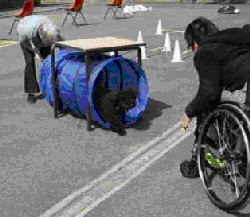 |
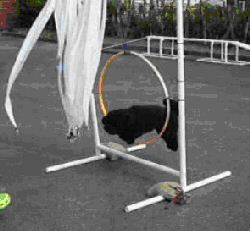 |
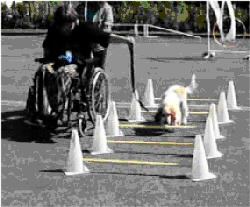 |
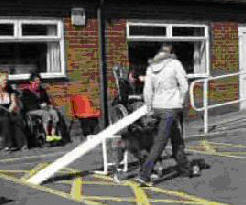 |
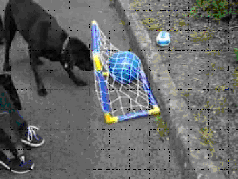 |
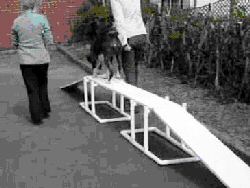 |
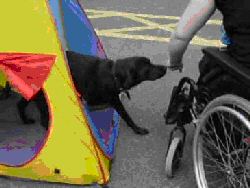 |
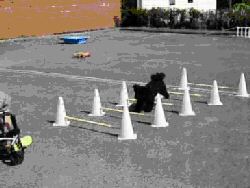 |
Assistance dogs need to be quiet when left so we tied them up inside the
hall with my husband in charge whilst we walked the course and I explained the exercises.
Each handler then 'walked the course' with their own dog while being marked in their ability to
control their dogs without resorting to treats or too much use of the lead. The dogs had to
keep their position without pulling, pay attention to the handler, ignore food placed at
strategic spots.
During this part of the
exercise, the handlers who weren't working their
dogs were given noise making items to act as a distraction, They banged tins, honked the horn from a child's bike and squeezed a squeaky toy cheering as
they did. All the dogs did well despite the noise although Mac and Roxy were distracted by the
squeak.
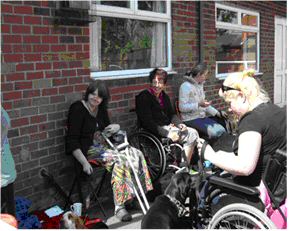 After the heelwork rounds, we all went inside for a cuppa before
starting on the obstacles. I laid food 'traps' but none of the dogs were caught out
although a couple came pretty close, especially as they passed Lulu with balloons in one hand
and a sausage in the other. After the heelwork rounds, we all went inside for a cuppa before
starting on the obstacles. I laid food 'traps' but none of the dogs were caught out
although a couple came pretty close, especially as they passed Lulu with balloons in one hand
and a sausage in the other.
I did a score sheet for each participant, giving an explanation of the exercise with
the points available and
points scored, which I emailed to them so they could see how can see how they had done.
Judging from the feedback, everybody enjoyed it and we had some good laughs.
For the rest of the month we'll be
working with the dogs in public places and teaching each dog the tasks that it’s owner needs it
to perform.
I hope to set one up a
new course once a month and
introduce different obstacles each time.
As Dog Aid is a charity, any donations would help them to
increase their help to disabled people. If you require more information about Dog Aid please
email Sandra Fraser at clanfraser33@hotmail.com
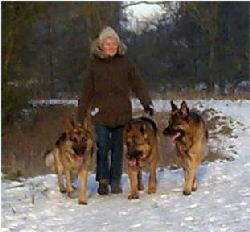 About
the author... About
the author...
Elaine Fairhurst is new to agility and only got involved with it to try and help one of
her clients who wanted to try it.
She
lives in Lancashire.
| 







 After the heelwork rounds, we all went inside for a cuppa before
starting on the obstacles. I laid food 'traps' but none of the dogs were caught out
although a couple came pretty close, especially as they passed Lulu with balloons in one hand
and a sausage in the other.
After the heelwork rounds, we all went inside for a cuppa before
starting on the obstacles. I laid food 'traps' but none of the dogs were caught out
although a couple came pretty close, especially as they passed Lulu with balloons in one hand
and a sausage in the other. About
the author...
About
the author...